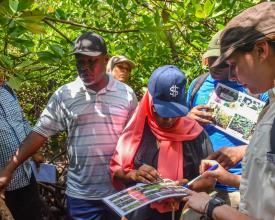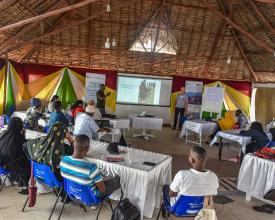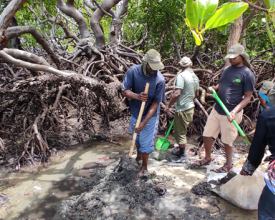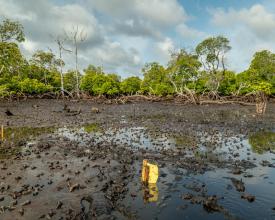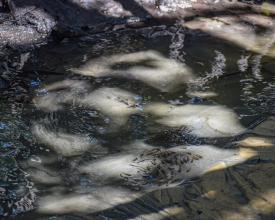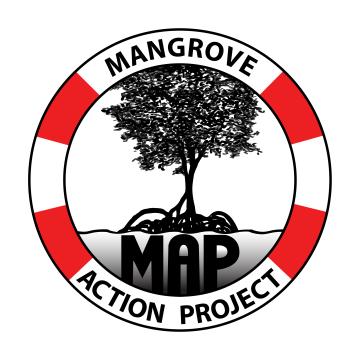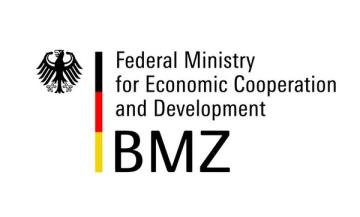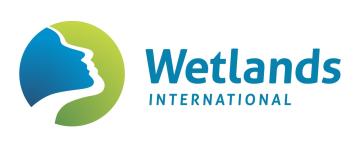
Les racines du changement : Restauration écologique communautaire de la mangrove au Kenya
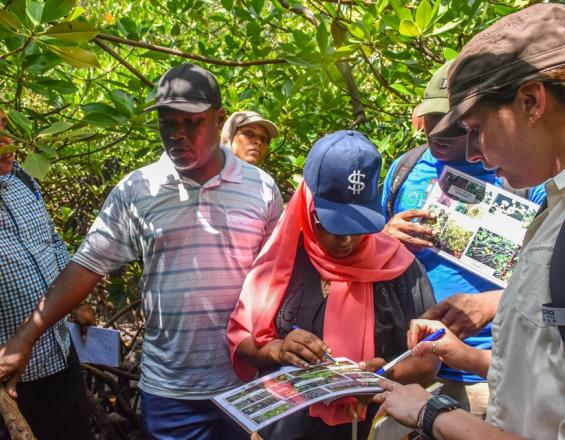
Les mangroves de Lamu et de Tana représentent plus de 65 % (40 610 ha) des forêts de mangroves du Kenya, qui couvrent 61 271 ha. Ces écosystèmes essentiels ont été et sont actuellement menacés principalement par l'exploitation forestière pour les poteaux et le bois de chauffage, le développement des infrastructures, l'urbanisation, la pollution et les effets du changement climatique. Bien que bien intentionnés, les efforts de restauration des mangroves déployés par le gouvernement, les organisations de la société civile, les communautés et le secteur privé se concentrent souvent uniquement sur la plantation. Cette approche néglige des facteurs tels que le débit d'eau, les nutriments, la dynamique des sédiments, la gouvernance et les conditions socio-économiques, qui sont tous essentiels à la santé à long terme des mangroves et au rétablissement de l'écosystème.
Pour remédier à cette situation, Wetlands International s'est associé au Service forestier du Kenya et au Mangrove Action Project en 2022 pour introduire la restauration écologique communautaire des mangroves (CBEMR) sur la côte kenyane. Le CBEMR prend en compte les aspects écologiques, sociaux et politiques des écosystèmes de mangrove, en donnant la priorité à la conservation et à la régénération naturelle plutôt qu'à la plantation.
Contexte
Défis à relever
Environnement :
Selon le plan national de gestion des écosystèmes de mangroves (2017-2027), environ 15 587 ha de mangroves à Lamu et Tana sont dégradés, pour un total national de 24 585 ha. Cette dégradation et cette perte menacent les fonctions essentielles des mangroves, notamment la protection des côtes, les habitats de pêche et la séquestration du carbone.
Sociales :
Une restauration réussie des mangroves nécessite la participation active des communautés. Cependant, la méconnaissance de la valeur écologique et économique des mangroves, associée au mépris fréquent des connaissances traditionnelles, entrave une gestion efficace et conduit à des pratiques non durables. Ce manque d'engagement est aggravé par l' accent mis sur la restauration par plantation uniquement, qui néglige souvent des facteurs écologiques, socio-économiques et politiques essentiels.
Les facteurs politico-économiques :
Malgré les cadres politiques existants en matière de conservation des mangroves, une application insuffisante et des budgets limités permettent la poursuite d'activités humaines préjudiciables. À cela s'ajoute une compréhension limitée de la valeur des mangroves par les décideurs politiques.
Emplacement
Traiter
Résumé du processus
Les éléments constitutifs sont organisés selon les cinq grandes étapes de l'initiative :
1) Sensibilisation et renforcement des capacités des principales parties prenantes à l'approche du CCREM, jetant ainsi les bases d'un engagement fructueux. Grâce aux champions de la communauté , nous avons créé un sentiment d'appropriation et de participation aux efforts de restauration et catalysé la diffusion des connaissances. L'alignement du renforcement des capacités sur la politique garantit que les efforts locaux sont soutenus par des politiques habilitantes et met en évidence la valeur des mangroves pour les décideurs.
2) L'établissement d'un site de démonstration qui a fourni une plateforme d'apprentissage pratique pour consolider les connaissances et présenter les avantages tangibles de l'approche du CCREM ;
3) Enfin, en intégrant le retour d'information de la communauté et en utilisant les données pour informer les ajustements stratégiques, nous avons mis en œuvre un cadre de suivi collaboratif qui garantit que les efforts de restauration sont continuellement affinés pour maximiser le succès, fournir des preuves de l'efficacité de l'approche du CBEMR et de la réalisation de la durabilité à long terme.
Blocs de construction
Renforcement des capacités, partage des connaissances et sensibilisation au CCRE avec les parties prenantes
Ce module permet aux communautés locales, aux agences gouvernementales et aux autres parties prenantes d'acquérir les connaissances, les compétences et les outils nécessaires à la mise en œuvre et à la pérennisation d'initiatives efficaces de restauration des mangroves. Grâce à un engagement stratégique et à des efforts de renforcement des capacités, les parties prenantes sont dotées de l'expertise technique et des ressources nécessaires à la restauration écologique communautaire des mangroves (CBEMR). Ces efforts comprennent l'identification et la formation de champions de la restauration écologique communautaire des mangroves (CBEMR) afin qu'ils servent de catalyseurs pour la diffusion des connaissances et les activités pratiques de restauration au sein de leurs communautés et de leurs institutions.
Wetlands International a lancé des activités de renforcement des capacités en engageant les communautés locales de Lamu et de Tana par le biais d'organisations communautaires, d'associations de consommateurs et d'agences gouvernementales clés, notamment KFS, KEFRI, KMFRI, le gouvernement du comté de Lamu, ainsi que des organisations de la société civile telles que le WWF et le Northern Rangelands Trust. Les femmes représentaient 50 % des participants, jouant un rôle de premier plan dans les efforts pratiques de restauration des mangroves. Les sessions de formation comprenaient des techniques de restauration solides basées sur l'approche du CBEMR, menées en anglais et traduites en swahili pour une plus grande accessibilité. Ces sessions ont permis d'intégrer la science des mangroves, pratique et réaliste, aux connaissances indigènes, favorisant ainsi l'inclusion et l'appropriation par les communautés.
En outre, les parties prenantes ont reçu des outils simples tels que des réfractomètres et des bandelettes de pH pour effectuer des tests de salinité et d'acidité, ainsi que des ressources pour soutenir le suivi et la gestion adaptative.
Les champions du CCREB, nommés par les CFA, les BMU, les groupes de jeunes, les groupes de femmes et les agences gouvernementales, ont amplifié ces efforts. Ces champions contribuent à la mobilisation des communautés, à la sensibilisation, à la conduite des activités de restauration, au suivi des progrès et à la réalisation d'évaluations écologiques et sociales. Les champions des agences gouvernementales servent également de formateurs de formateurs pour assurer un renforcement continu des capacités au sein de leurs institutions et de leurs communautés.
Sur la base du succès des formations initiales à Lamu et dans d'autres sites, les responsables du KFS de Lamu, en collaboration avec Wetlands International, ont identifié le besoin de diffuser ces connaissances principalement au niveau de la politique et de la gestion au sein du KFS parmi d'autres parties prenantes clés. En partenariat avec le KFS et le PAM, nous avons organisé une formation à la gestion du CBEMR pour les cadres supérieurs et les gestionnaires des forêts côtières du KFS, les directeurs du département de l'environnement des comtés de Kwale, Kilifi, Mombasa, Tana River et Lamu, les universitaires de la Kenya School of Forestry et de l'Université Kenyatta, les organisations partenaires de Global Mangrove Alliance, à savoir l'UICN, le WWF et TNC, ainsi que les représentants du Western Indian Ocean Mangrove Network et les journalistes locaux spécialisés dans les questions d'environnement.
La collaboration avec les OSC, l'Alliance mondiale pour la mangrove et d'autres partenaires a renforcé la portée et l'impact de l'initiative, permettant des activités régulières de formation et de partage des connaissances dans les régions de mangrove.
Facteurs favorables
Approches participatives et holistiques: La conception participative du CCRE met en relation les utilisateurs des ressources avec les institutions de recherche, les gouvernements locaux, les agences de conservation et la société civile, en tirant parti de leurs connaissances locales et de leur expertise. Cette approche garantit un engagement holistique et l'intégration de diverses perspectives.
Sélection stratégique et autonomisation des champions: Les champions ont été choisis en fonction de leurs qualités de leadership, de leurs compétences en matière de communication et de leur intérêt pour la conservation des mangroves. Une représentation diversifiée, comprenant des femmes, des jeunes et des dirigeants communautaires, a permis d'améliorer l'inclusion. Les champions ont été dotés de connaissances, de compétences, de ressources et d'un mentorat permanent, ce qui a permis une mobilisation efficace de la communauté et un transfert de connaissances. Des rôles et des responsabilités clairement définis permettent de s'assurer que les champions comprennent leurs contributions et peuvent défendre efficacement la conservation des mangroves au sein de leurs communautés et de leurs agences. Wetlands International a contribué à la création d'un système de communication et de coordination, de mécanismes de retour d'information par le biais de réunions régulières et d'opportunités de partage des connaissances et de résolution conjointe des problèmes. Outre la formation, l'autonomisation des champions a été la clé du succès de l'initiative. Il s'agit de leur fournir les ressources nécessaires, y compris les outils et le soutien financier, afin qu'ils puissent s'acquitter efficacement de leurs tâches. Il est tout aussi important de reconnaître et de valoriser leurs contributions, de leur proposer des incitations qui les motivent et de leur offrir des possibilités de développement personnel et professionnel. Cette approche permet non seulement de renforcer leur engagement, mais aussi d'inciter d'autres personnes à participer activement aux efforts de conservation des mangroves.
Des partenariats solides: La collaboration entre Wetlands International, KFS, KEFRI, KMFRI, les communautés locales et les OSC a facilité le partage des connaissances, la mobilisation des ressources et l'influence sur les politiques.
Rôles de genre et groupements sociaux: La reconnaissance du rôle central des femmes dans les activités de restauration de la mangrove et l'existence d'organisations communautaires relativement bien établies à Lamu ont favorisé l'engagement et l'appropriation par les parties prenantes. Une planification tenant compte de la dimension de genre a permis de garantir que les initiatives soient inclusives et aient un impact.
Accès à l'information et aux ressources: Des supports de formation en anglais et en swahili, des outils simples à utiliser et des ateliers pratiques ont favorisé le transfert de connaissances, permettant aux parties prenantes de mettre en œuvre le CCREM de manière efficace.
Un environnement politique favorable: Les efforts de formation ont incité le KFS et d'autres agences gouvernementales à intégrer les principes du CBEMR dans les directives nationales et les stratégies de gestion, favorisant ainsi un cadre politique propice à la restauration durable des mangroves. La collaboration avec le KFS et le KEFRI sur l'utilisation et l'application de l'approche CCRE a permis de réviser les directives nationales de restauration qui prennent en compte les informations sur le CCRE.
Approche de gestion adaptative: Le suivi régulier des activités de restauration a permis aux parties prenantes d'adapter les stratégies, de tirer les leçons des expériences et d'améliorer les résultats au fil du temps, garantissant ainsi un succès à long terme.
Leçon apprise
Le partage des connaissances est essentiel: La diffusion d'informations et de bonnes pratiques dans les langues locales garantit l'inclusivité et favorise une adoption plus large de l'approche du CCREM. Rendre l'information accessible facilite la compréhension, la contribution et la participation de diverses communautés.
Les champions sont de puissants agents de changement: Investir dans des champions ciblés ayant de l'influence et des réseaux amplifie la portée et l'impact des efforts de restauration des mangroves. En leur donnant les moyens d'acquérir des compétences, des ressources et des incitations, on renforce leur engagement et on suscite un engagement plus large de la part de la communauté.
La diversité et la représentation sont importantes: La sélection de champions issus de milieux diversifiés garantit que les initiatives de restauration sont inclusives et répondent aux différents besoins de la communauté.
La collaboration renforce l'efficacité: Faciliter la collaboration entre les champions et les parties prenantes favorise l'apprentissage mutuel, le partage des connaissances et l'action collective, ce qui accroît l'efficacité des efforts de restauration.
Les politiques doivent être adaptables: Des politiques souples fondées sur les données de suivi et les enseignements tirés sont essentielles pour relever les nouveaux défis et améliorer les pratiques de restauration. Pour ce faire, les gestionnaires forestiers nationaux devraient participer aux initiatives de restauration locales et infranationales afin de contribuer à l'élaboration des politiques relatives aux forêts de mangrove. Par exemple, compte tenu du succès de la première formation du CCREM à Lamu, les agents du KFS de la région ont identifié la nécessité de diffuser ces connaissances auprès de l'équipe de gestion du KFS, des responsables politiques de haut niveau et d'autres parties prenantes clés.
L'autonomisation est le moteur de la réussite: Fournir aux champions des outils, un soutien financier et des opportunités de croissance personnelle et professionnelle inspire l'engagement et favorise une conservation durable menée par la communauté.
Création d'un site de démonstration du CCRE pour l'apprentissage et la recherche
Le site de Kitangani, situé près de Mokowe, a connu des problèmes hydrologiques sous-jacents après que le sable dragué du canal a été déversé sur le site de la mangrove. Au fil du temps, les canaux d'eau ont été considérablement bloqués, ce qui a entravé la circulation de l'oxygène et des nutriments essentiels à la régénération et à la croissance de la mangrove.
En partenariat avec le KFS, le Kenya Forestry Research Institute (KEFRI) et le Mangrove Action Project (MAP), Wetlands International a commencé les efforts de restauration du site de Kitangani en réunissant un large groupe de parties prenantes. Nous avons impliqué les communautés locales par le biais d'organisations communautaires telles que Pate Resources and Tourism Initiative (PRATI) et Lamu Community Forest Association (LAMACOFA), ainsi que le Kenya Marine and Fisheries Research Institute (KMFRI) et le gouvernement du comté de Lamu.
Les débris ont été retirés du canal principal afin d'améliorer les conditions biophysiques, notamment la qualité du sol, les niveaux d'oxygène et la disponibilité des nutriments, favorisant ainsi la régénération naturelle. En outre, un nettoyage du site a été effectué, car la pollution plastique reste un problème persistant dans l'archipel de Lamu. Des quadrants ont également été définis à des fins de surveillance.
Facteurs favorables
Sélection du site et partenariats :
La mise en place d'un site de démonstration du CCRE commence par la sélection d'une zone de mangrove dégradée présentant un potentiel de restauration élevé et accessible pour la participation de la communauté. Il est essentiel de tenir compte des caractéristiques écologiques du site, telles que l'hydrologie, la salinité et la composition des espèces. Il est tout aussi important de veiller à ce que les dispositions relatives à la propriété ou au régime foncier soient claires afin d'éviter les conflits et de promouvoir la viabilité à long terme. Des partenariats solides sont également essentiels, rassemblant les agences gouvernementales, les instituts de recherche, les ONG et les communautés locales pour une collaboration efficace. Des rôles, des responsabilités et des canaux de communication clairs entre les partenaires permettront de coordonner les efforts et d'utiliser efficacement les ressources. Par exemple, le KEFRI a pris la tête du suivi de la réussite des interventions, tandis que le KFS a veillé à ce que toutes les approbations pour l'action de restauration soient en place et à ce que les acteurs concernés soient mobilisés.
Engagement communautaire et expertise technique :
L'engagement communautaire est au cœur d'un site de démonstration du CCREM. Les communautés locales doivent être activement impliquées dans toutes les étapes du projet, de la planification et de la mise en œuvre au suivi et à l'évaluation. L'intégration des connaissances écologiques traditionnelles et des perspectives communautaires dans les stratégies de restauration garantit des solutions durables et culturellement appropriées. Cette approche participative a suscité un sentiment d'appropriation et de responsabilité chez les membres de la communauté, contribuant ainsi à la réussite à long terme du projet. En outre, l'accès à l'expertise technique en matière d'écologie des mangroves, d'hydrologie et de techniques de restauration est crucial. L'engagement de spécialistes du PAM, du KMFRI, du KFS et du KEFRI pour mener des évaluations de sites, élaborer des plans de restauration et fournir des conseils techniques garantit que le projet repose sur des bases scientifiques solides et sur les meilleures pratiques. Faciliter le transfert de connaissances et le renforcement des capacités des membres de la communauté et des praticiens locaux leur permet de participer activement aux efforts de restauration et de les soutenir.
Mobilisation des ressources et suivi :
Des ressources adéquates sont nécessaires pour la mise en place et l'entretien d'un site de démonstration de l'initiative CBEMR. Il s'agit notamment d'assurer le financement de la préparation du site, des activités de restauration, de l'équipement de surveillance et de l'engagement de la communauté. La mobilisation de contributions en nature de la part des partenaires, telles que la main-d'œuvre, les matériaux et l'expertise technique, peut permettre d'optimiser l'utilisation des ressources. La mise en place de mécanismes de financement durables est essentielle pour l'entretien et le suivi à long terme des sites, afin de garantir la pérennité de l'impact du projet. Un plan de suivi complet est également nécessaire pour suivre les progrès, évaluer l'efficacité des techniques de restauration et documenter les enseignements tirés. L'utilisation d'outils et de technologies de suivi appropriés, tels que l'outil de suivi de la restauration des mangroves et le Global Mangrove Watch, permet de prendre des décisions fondées sur des données et d'assurer une gestion adaptative.
Le partage des résultats de la surveillance avec les parties prenantes par l'intermédiaire des comités nationaux et infranationaux de gestion des mangroves favorise la transparence et la responsabilité, ainsi que l'apprentissage collaboratif et l'amélioration continue.
Leçon apprise
La restauration hydrologique est essentielle : Pour faciliter la régénération naturelle et améliorer les conditions du site, il était essentiel de s'attaquer aux problèmes hydrologiques sous-jacents en dégageant les canaux d'eau obstrués.
L'implication des communautés est essentielle : L'engagement des communautés locales par l'intermédiaire des organisations communautaires a permis de garantir leur participation et leur appropriation du processus de restauration.
Les partenariats renforcent l'efficacité : La collaboration avec le KFS, le KEFRI, le MAP, le KMFRI et le gouvernement du comté de Lamu a apporté une expertise, des ressources et un soutien précieux. Ces groupes contribuent également à l'extension des initiatives fructueuses du CBEMR.
Les sites de démonstration offrent de précieuses possibilités d'apprentissage : Le site de Kitangani sert d'exemple pratique des principes du CCRE, facilitant l'apprentissage et le partage des connaissances entre les parties prenantes.
Suivi et évaluation pour une pratique fondée sur des données probantes et la durabilité
Ce module met l'accent sur la participation des communautés au suivi, en utilisant la science citoyenne et des plateformes de données accessibles pour garantir que les connaissances locales informent la gestion adaptative et contribuent au succès à long terme de la restauration de la mangrove.
Facteurs favorables
Un suivi et une évaluation efficaces sont nécessaires pour une gestion adaptative et une réussite à long terme de la restauration des mangroves. Lors de la mise en œuvre du CBEMR, Wetlands International a élaboré un plan de restauration avec des buts et des objectifs clairement définis et alignés sur des indicateurs mesurables et pertinents.
Pour garantir une collecte de données précise et cohérente, diverses méthodes ont été utilisées, notamment des enquêtes, des observations sur le terrain, la télédétection et l'utilisation de l'outil de suivi de la restauration des mangroves (Mangrove Restoration Tracker Tool). Cet outil, intégré à la plateforme Global Mangrove Watch, a fourni un cadre standardisé pour documenter et suivre les progrès de la restauration, facilitant l'apprentissage et l'échange d'informations entre les praticiens.
Renforcement des capacités des champions de la mangrove des comtés de Lamu et de Tana grâce à des formations standardisées du CCREM et à des outils permettant d'intégrer les initiatives de science citoyenne dans le suivi de la restauration de la mangrove.
La création de plateformes pour le retour d'information et la contribution des communautés , telles que les comités nationaux et infranationaux de gestion des mangroves, garantit l'intégration des connaissances et des perspectives locales dans les stratégies de gestion adaptative. En utilisant les données de suivi pour éclairer la prise de décision et adapter les stratégies de projet, les efforts de restauration tels que ceux des sites de Kitangani et de Pate ont été continuellement améliorés afin de maximiser l'efficacité et d'obtenir un succès à long terme.
Leçon apprise
La mise en œuvre de l'approche du CCRE au Kenya nous a permis de tirer les enseignements suivants :
- La gestion adaptative est essentielle : Les données de suivi ont permis un apprentissage continu et l'adaptation des stratégies de restauration sur la base des résultats observés.
- L'implication des communautés est nécessaire : L'implication des communautés qui interagissent quotidiennement avec l'écosystème dans le suivi des efforts de restauration renforce l'appropriation et garantit que les connaissances locales éclairent la prise de décision.
- L'accessibilité et la transparence des données sont essentielles : Le partage des résultats de la surveillance avec les parties prenantes favorise la responsabilisation et facilite la collaboration et l'apprentissage mutuel.
- Le suivi à long terme est nécessaire : Le suivi des progrès au fil du temps permet d'obtenir des informations précieuses sur les effets à long terme des efforts de restauration.
Impacts
Cette initiative de restauration a eu des effets positifs importants sur les plans environnemental, social et économique.
Environnement : le site de démonstration de Kitangani affiche des progrès remarquables, avec une eau qui s'écoule librement et une repousse visible un an seulement après son établissement. Cela montre l'efficacité de l'approche du CCREM dans la restauration des processus hydrologiques et la facilitation de la régénération naturelle.
En outre, sur l'île de Pate et à Mkunumbi, Wetlands International a réussi à restaurer environ 200 hectares de zones de mangrove dégradées, contribuant ainsi à l'augmentation du couvert forestier et à l'amélioration des services écosystémiques.
Social : Wetlands International a considérablement sensibilisé les organisations communautaires et les communautés locales de Lamu et de Tana aux méthodes efficaces de restauration des mangroves. Ces connaissances permettent aux communautés de participer activement aux efforts de conservation et de gestion durable.
La collaboration avec les champions locaux de la mangrove a permis de renouveler le sens du leadership et de l'appropriation au sein des communautés. L'engagement des communautés dans des initiatives scientifiques citoyennes a été renforcé et l'intégration des connaissances locales a été encouragée.
L'économie : L'approche du CCREM s'est avérée plus efficace et plus rentable que les méthodes traditionnelles de plantation de mangroves. En donnant la priorité à la régénération naturelle, le CCREM réduit les coûts initiaux liés à l'achat et à la plantation de plants, qui peuvent être onéreux.
Bénéficiaires
Les bénéficiaires sont les communautés locales de Lamu (femmes, hommes, jeunes), les gestionnaires forestiers, les fonctionnaires et les universitaires formés à l'approche CCRE. Les champions communautaires amplifient l'impact en atteignant des communautés plus larges comme les CFA de PRATI, Mkunumbi, PANDAWE et LAMACOFA.
Objectifs de développement durable
Histoire

En 2011, le littoral de Lamu, une étendue vierge de beauté côtière, a commencé à changer. Des sections ont été draguées pour créer des canaux plus profonds pour le transport des bateaux, mais le processus, bien que bien intentionné, a déclenché une vague de conséquences inattendues. Le dragage a perturbé l'équilibre délicat de l'écosystème de la mangrove, bloquant des canaux d'eau vitaux et déclenchant un effondrement lent mais régulier de l'environnement. Le site de Kitangani, près de la ville de Mokowe, est devenu l'une des zones les plus visiblement touchées, ses mangroves luttant pour leur survie. Malgré de multiples tentatives pour restaurer les mangroves, les efforts ont semblé vains et Kitangani a été qualifié d'"impossible" à réhabiliter.
Mais en septembre 2022, Wetlands International, aux côtés de KFS, KEFRI, MAP et des champions locaux du CCREM, a lancé un nouvel effort pour restaurer Kitangani. Après une évaluation approfondie, l'équipe a commencé la restauration en ouvrant des canaux bloqués et en établissant des parcelles de surveillance. L'objectif était de restaurer l'hydrologie de la zone, d'améliorer les niveaux de sol et d'oxygène, et d'équilibrer le flux de nutriments pour soutenir la régénération de la mangrove.
En mars 2024, des progrès significatifs avaient été réalisés sur le site. En l'espace de neuf mois, la zone précédemment inondée a commencé à s'assécher progressivement et de nouveaux plants de palétuviers ont émergé. Les arbres mères, autrefois stressés par le faible débit d'eau, ont également commencé à se régénérer. Des jeunes pousses ont également été repérées dans le canal d'eau, marquant ainsi le retour de la nature.
Mais l'histoire de la restauration ne s'est pas arrêtée à Kitangani. À l'est, à Pate, et à l'ouest, à Mkunumbi, deux autres sites ont été victimes de la dégradation. Chukuchu, autrefois dévasté par l'exploitation traditionnelle du calcaire, et Mto wa Simba, ravagé par les pluies catastrophiques d'El Niño en 1997, avaient tous deux désespérément besoin d'aide. Avec les mêmes principes et la même détermination, Wetlands International, la communauté et KFS ont porté leur attention sur ces sites en 2022. Grâce à l'application de l'approche du CBEMR et à la plantation assistée là où c'est nécessaire, les sites ont maintenant la même transformation positive.
Ces efforts ne se limitent pas à la restauration des mangroves : ils ont ravivé l'espoir des communautés locales et des principales institutions gouvernementales. Ces sites sont devenus des salles de classe vivantes, qui enseignent des leçons précieuses en matière de restauration des mangroves, d'engagement communautaire et de pratiques durables.
